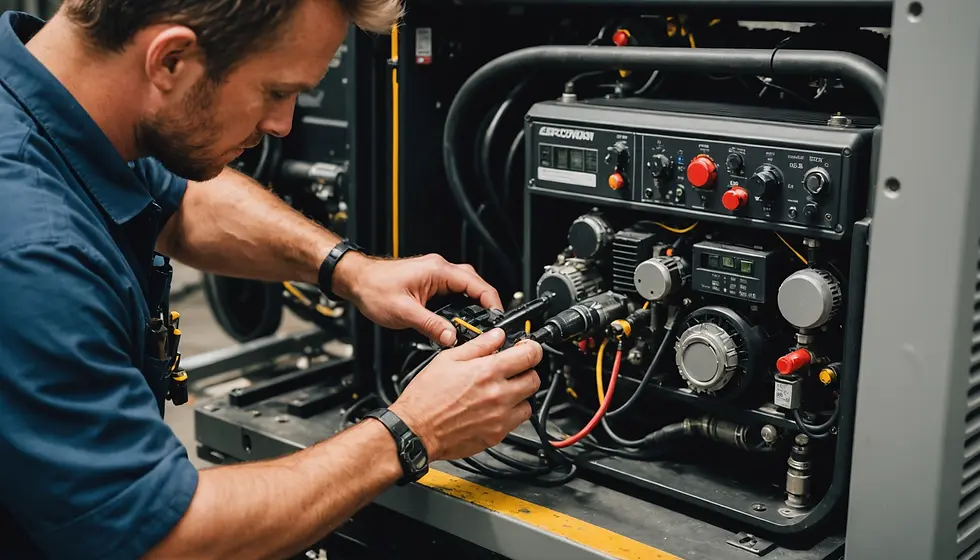Generator Cooling Systems: Radiators, Coil Coolers & Efficiency Considerations
- elearning@ensemble
- Sep 2
- 2 min read

Generators produce significant heat during operation, and without a proper cooling system, they risk overheating, inefficiency, or even complete failure. Cooling systems play a critical role in maintaining safe operating temperatures, improving efficiency, and extending the life of diesel generators.
This blog explains the types of cooling systems used in generators—radiators, coil coolers, and advanced systems—while also highlighting their efficiency and maintenance requirements.
1. Importance of Generator Cooling Systems
Diesel engines in generators burn fuel continuously, which produces high temperatures. If not properly managed, this heat can:
Damage the engine and alternator windings.
Cause lubrication breakdown in oils.
Lead to reduced efficiency and shorter lifespan.
Thus, cooling systems are essential for:✅ Maintaining engine performance✅ Improving fuel efficiency✅ Ensuring long-term reliability
2. Radiator Cooling Systems
2.1 How It Works
Radiator cooling systems are the most common method for medium to large generators. The radiator circulates coolant through the engine block, absorbing heat. A fan then blows air through the radiator, removing the heat.
2.2 Advantages
✔ Widely used, simple design.✔ Effective for continuous operation.✔ Easy to maintain with regular coolant checks.
2.3 Challenges
⚠ Requires regular cleaning to prevent dust blocking airflow.⚠ Coolant leaks can lead to overheating.
3. Coil Cooler Systems
3.1 How It Works
In coil cooler systems, heat from the engine is transferred to cooling coils, which are immersed in a water tank or cooling medium. Heat is dissipated through natural convection or with external cooling arrangements.
3.2 Applications
Commonly used in marine generators and installations where radiators are impractical.
Useful in environments with restricted airflow.
3.3 Advantages
✔ Compact design for space-limited installations.✔ No dependence on radiator fans.
3.4 Challenges
⚠ Requires a continuous supply of cooling water.⚠ Maintenance can be more complex than radiators.
4. Other Cooling Systems
Air-Cooled Systems
Best for small portable generators (up to 15 kVA).
Use direct air circulation instead of coolant.
Hybrid & Advanced Cooling Systems
Some modern generators use hybrid cooling, combining air, liquid, and coil systems for greater efficiency.
Used in large power plants and industrial setups.
5. Efficiency Considerations in Cooling Systems
The choice of cooling system affects generator performance and efficiency.
✔ Fuel Efficiency – Well-maintained cooling prevents unnecessary fuel consumption.✔ Load Handling – Generators under heavy load require robust cooling systems.✔ Ambient Conditions – Hot and humid climates demand stronger radiator and coil cooler designs.✔ Maintenance Costs – Regular coolant changes, cleaning, and inspection reduce long-term expenses.
6. Maintenance Best Practices for Cooling Systems
✅ Regularly check coolant levels and quality.✅ Inspect hoses, pipes, and connections for leaks.✅ Clean radiators and fans to avoid dust accumulation.✅ Monitor coolant temperature with temperature sensors and alarms.
Wrapping Up
Generator cooling systems—whether radiator-based, coil cooler, or air-cooled—are vital for maintaining safe operation, efficiency, and equipment longevity. Choosing the right cooling system depends on generator size, environment, and load requirements.
In the next blog, we will explore Additional Generator Components: Governing Systems, Acoustic Enclosures & Noise Standards in India. Stay tuned!







Comments